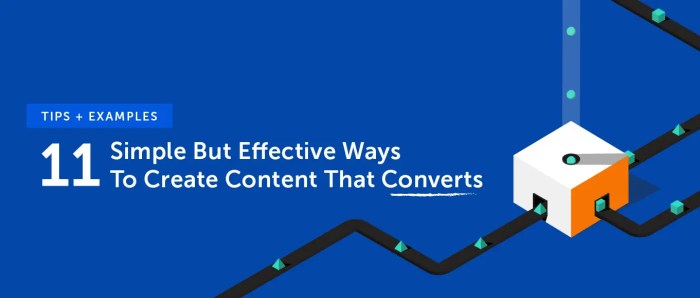Developing Content That Converts kicks off with understanding your audience, crafting compelling headlines, utilizing visual content, call-to-action strategies, and A/B testing for optimization. This topic delves into the key elements needed to create content that resonates with your audience and drives conversions.
Understanding Your Audience

When developing content that converts, it is crucial to have a deep understanding of your target audience. Knowing who your audience is allows you to tailor your content to their specific needs, preferences, and interests, increasing the likelihood of engagement and conversion.
Importance of Demographic Research
Demographic research provides valuable insights into the characteristics of your audience, such as age, gender, location, income level, education, and more. By analyzing demographic data, you can create content that resonates with specific audience segments, ensuring that your message is relevant and relatable to the people you are trying to reach.
- Identifying target demographics helps in crafting personalized content that speaks directly to the needs and preferences of different audience groups.
- Understanding demographic trends can guide decisions on tone, language, imagery, and messaging that will appeal to specific demographics.
- Demographic research enables you to target your marketing efforts more effectively, reaching the right people with the right message at the right time.
Role of Psychographic Information, Developing Content That Converts
Psychographic information goes beyond demographics to delve into the interests, values, attitudes, lifestyles, and behaviors of your audience. By understanding the psychographics of your target audience, you can create content that speaks to their emotions, aspirations, and beliefs, forging a deeper connection and driving conversions.
- Psychographic insights help in developing content that resonates with the values and interests of your audience, building trust and credibility.
- Understanding the psychographics of your audience allows you to create content that aligns with their lifestyle choices and purchasing behaviors.
- Psychographic information can inform content strategies that evoke specific emotions or tap into shared beliefs, triggering desired actions from your audience.
Crafting Compelling Headlines
Crafting compelling headlines is crucial in capturing the attention of your audience and driving conversions. A catchy headline can entice readers to click on your content, engage with your message, and ultimately take action, whether it’s making a purchase or signing up for a service.
Tips for Creating Headlines
- Keep it concise and to the point: Aim for headlines that are clear and easy to understand at a glance.
- Use power words: Incorporate strong and persuasive language to evoke emotion and curiosity.
- Highlight the benefit: Communicate what the reader will gain or learn from your content.
- Create urgency: Include words that convey a sense of urgency to prompt immediate action.
- Avoid clickbait: While it’s important to be engaging, make sure your headline accurately reflects the content to build trust with your audience.
Impact of Different Headline Styles
Headline styles such as questions, lists, and how-tos can each have a unique impact on audience engagement:
- Questions: Asking a question in your headline can pique curiosity and encourage readers to seek answers within your content.
- Lists: Numbered lists can make your content more scannable and promise a clear structure for readers to follow.
- How-tos: How-to headlines offer practical value to readers, positioning your content as a helpful resource they can apply in their own lives.
Utilizing Visual Content: Developing Content That Converts
Visual content such as images, videos, and infographics plays a crucial role in enhancing content conversion rates. These elements not only make the content more engaging but also help in conveying complex information effectively to the audience. By incorporating visually appealing elements, you can capture the attention of the viewers and compel them to take action.
Selecting Visual Elements
When selecting visual elements to complement written content, it is essential to choose images, videos, or infographics that are relevant to the topic and resonate with the audience. High-quality and professional visuals can significantly impact the overall perception of the content and increase its credibility. Additionally, ensure that the visual elements align with the brand’s aesthetics and messaging to maintain consistency across all platforms.
Visual Hierarchy and Conversion Flow
Visual hierarchy plays a crucial role in guiding audience attention and improving conversion flow. By strategically placing visual elements such as captivating images or compelling videos, you can direct the viewers’ focus towards the key messages or Call-to-Actions (CTAs). Utilizing a hierarchy of visuals helps in creating a seamless flow of information, leading the audience through the content and ultimately driving conversions.
Remember to balance the visual elements with the written content to create a cohesive and engaging user experience.
Call-to-Action Strategies
In the world of digital marketing, call-to-action (CTA) strategies play a crucial role in converting leads into customers. A well-crafted CTA can prompt your audience to take the desired action, whether it’s signing up for a newsletter, making a purchase, or downloading a resource. Let’s dive into the key components of an effective CTA and how they can impact conversion rates.
Key Components of an Effective CTA
- Clear and Direct Language: A successful CTA uses concise and compelling language that clearly communicates the action you want the audience to take.
- Strong Visual Elements: Utilize eye-catching design elements such as buttons, colors, and placement to draw attention to the CTA.
- Sense of Urgency: Creating a sense of urgency can motivate users to act quickly, whether it’s through limited-time offers or countdown timers.
- Relevant Placement: Position your CTA strategically within your content, ensuring it’s visible and easily accessible to the audience.
Examples of Compelling CTAs and Impact on Conversion Rates
- Example 1: “Start Your Free Trial Today!”
-This CTA effectively conveys the benefit of trying out a product or service without any initial cost, leading to a higher conversion rate. - Example 2: “Get 50% Off – Shop Now!”
-By offering a discount and creating a sense of urgency with the “Shop Now” button, this CTA can drive immediate action from potential customers.
Importance of CTA Placement, Design, and Wording
- Placement: The location of your CTA within your content can significantly impact its visibility and effectiveness. Experiment with different placements to see where your audience is most responsive.
- Design: A well-designed CTA that stands out from the rest of the content can attract the audience’s attention and encourage them to click. Use contrasting colors, bold fonts, and clear buttons to make it visually appealing.
- Wording: The language you use in your CTA should be action-oriented and persuasive. Use verbs like “Start,” “Join,” or “Discover” to prompt users to take action immediately.
A/B Testing for Optimization

A/B testing is a method used to compare two versions of a webpage or app against each other to determine which one performs better. This process helps in refining content for better conversion outcomes by analyzing user behavior and preferences.
Elements for Testing
- Headlines: Testing different wording, length, and tone to see which attracts more clicks.
- Call-to-Actions (CTAs): Trying out different colors, placements, and wording to optimize for conversions.
- Visuals: Testing images, videos, or infographics to see which ones resonate best with the audience.
Analyzing Results and Iteration
When analyzing A/B test results, it’s crucial to look at key metrics such as click-through rates, bounce rates, and conversion rates. By identifying the variations that performed better, you can iterate on your content to continuously improve conversion outcomes.
